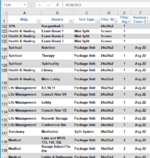Hi, I am tracking due dates for HVAC filters in a very large resort. There are many instances where I need to look at the status of the filters that are due up to the current date and any filters that have been over due. I was hoping to pull this data into a separate worksheet since there are so many other columns of HVAC data that is not necessary when looking at just the status of the filters. Please see attached image. I tried to upload a mini-sheet, but I think the network security prevented me from using the add-in. Thank you in advance for any assistance.
-
If you would like to post, please check out the MrExcel Message Board FAQ and register here. If you forgot your password, you can reset your password.
You are using an out of date browser. It may not display this or other websites correctly.
You should upgrade or use an alternative browser.
You should upgrade or use an alternative browser.
Lookup rows with dates for the current month and any previous months.
- Thread starter Stanr
- Start date
Excel Facts
Difference between two dates
Secret function! Use =DATEDIF(A2,B2,"Y")&" years"&=DATEDIF(A2,B2,"YM")&" months"&=DATEDIF(A2,B2,"MD")&" days"
Joe4
MrExcel MVP, Junior Admin
- Joined
- Aug 1, 2002
- Messages
- 72,314
- Office Version
- 365
- Platform
- Windows
Welcome to the Board!
Have you thought of using Advanced Filters to filter just the records you want to see to the new sheet?
Another popular option is to use Conditional Formatting to highlight the records that are overdue.
Have you thought of using Advanced Filters to filter just the records you want to see to the new sheet?
Another popular option is to use Conditional Formatting to highlight the records that are overdue.
Upvote
0
Hi,Welcome to the Board!
Have you thought of using Advanced Filters to filter just the records you want to see to the new sheet?
Another popular option is to use Conditional Formatting to highlight the records that are overdue.
I was hoping to retrieve this data on a separate worksheet with only the equipment ID and filter size and quantity for a concise report that is always active.There are numerous other columns with information that is not needed for this one action and it would be a challenge to filter the entire master worksheet every time. Thanks for the feedback, it is much appreciated.
Upvote
0
Joe4
MrExcel MVP, Junior Admin
- Joined
- Aug 1, 2002
- Messages
- 72,314
- Office Version
- 365
- Platform
- Windows
All things equal, the easiest thing I thing is to make this a dynamic interactive process.
For that, this would probably work much better in Microsoft Access, where it is easy to make dynamic interactive filters.
Or, you can use Power Query, which allows you to use database-like features right in Microsoft Excel.
If neither of those is an option, then VBA could probably be used, but you would need to spell out the details of exactly what you want, namely:
- what columns should be returned on the other sheet
- what are the exact critiera/filters you need (spell out each one, incuding the column letter and what values to include)
For that, this would probably work much better in Microsoft Access, where it is easy to make dynamic interactive filters.
Or, you can use Power Query, which allows you to use database-like features right in Microsoft Excel.
If neither of those is an option, then VBA could probably be used, but you would need to spell out the details of exactly what you want, namely:
- what columns should be returned on the other sheet
- what are the exact critiera/filters you need (spell out each one, incuding the column letter and what values to include)
Upvote
0
Joe4
MrExcel MVP, Junior Admin
- Joined
- Aug 1, 2002
- Messages
- 72,314
- Office Version
- 365
- Platform
- Windows
Note that if using Excel 365, there is a new FILTER function that you can use in formulas that may be helpful too.
See: FILTER function
See: FILTER function
Upvote
0
Your recommendation makes the most sense. I've been looking at the Filter function after reading your recommendation and I think there is a strong possibility that it could be the answer. I briefly looked at the apps that are available to me at work and I'm not sure that our organization has Access, but I'll confirm when I go back into my office next week. I have very little VBA experience so I'll also have to try and educate myself and see if I can find a solution. Thank you so much for your feedback.
Upvote
0
Similar threads
- Replies
- 3
- Views
- 290
- Question
- Replies
- 10
- Views
- 1K
- Question
- Replies
- 1
- Views
- 127
- Replies
- 1
- Views
- 285






